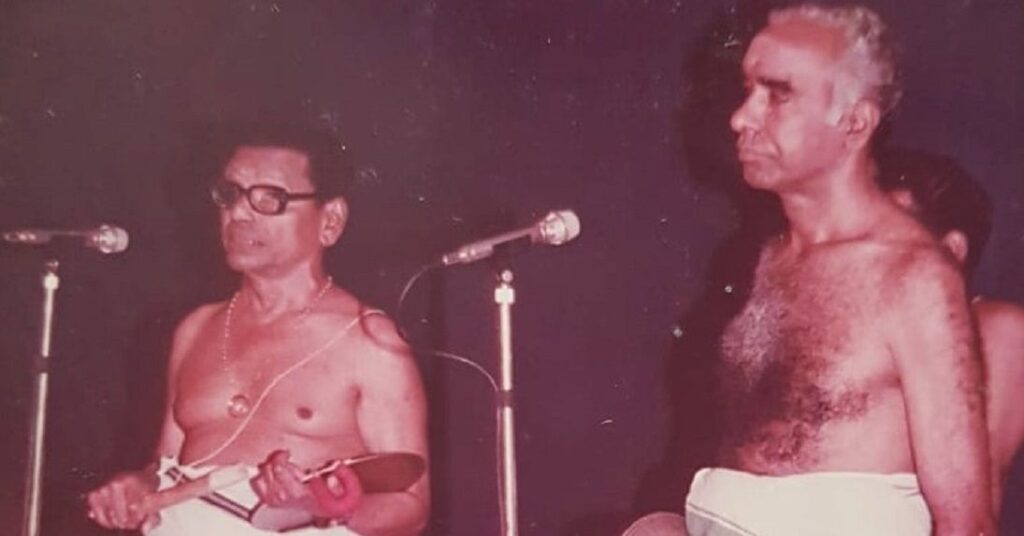Kerala Kalamandalam turns 90 today. On this date in 1932, the Kerala institution handheld its protege Neelakantan Nambisan to Kathakali stage. Year 2020 is the trendsetter’s centenary.
For young Neelakantan Nambisan, the Bharatapuzha in central Kerala functioned as downstream Cauvery along Tamil Nadu. In the late 1930s.
Those days, Nambisan was a student of Kathakali music. Kalamandalam, where he took lessons on vocals for the classical dance-theatre, was just south of the river. On the other bank was Mundaya village, near Shoranur.
The budding singer had to cross the Bharatapuzha to reach the guru’s house for higher studies. Venkitakrishna Bhagavathar, nearing 60, would eagerly train Nambisan. Back in Kalamandalam, Kavassery Swamikutty was his guru. Veteran Pulappatta Kuttan headed the wing.
Bhagavathar’s music carried Carnatic elements in much stronger dose than the other two teachers. For, he hailed from a Tamil Brahmin family with ancestry tracing to Thanjavur belt. His forefathers were into traditional Sampradaya Bhajana that flourished towards the end of the 18th century as a choral singing at temples in praise of gods.
Bhagavathar died in 1957 at the age of 76. By then Nambisan had risen in stature. He was ripe enough to mentor students. Indeed, he did have a legion of disciples during the three decades as a teacher in his alma mater. He subsequently taught at PSV Natyasangham in Kottakkal. Nambisan further carried out a historic mission: he refashioned the music for Krishnanattam dance-drama in the pilgrim town of Guruvayur.
For Kathakali, Nambisan best blended local Sopana Sangeetham with Carnatic, sounding a genre that came to define Kathakali music. It emerged along with an overall revival of the art-form with a fresh crop of practitioners in acting, percussion and make-up.
Debut & rise
Nambisan was only 12 when he debuted on Kathakali stage. That was on this day, nine decades ago. November 2, 1932. At Kalamandalam, on the second anniversary of the performing-arts institution found with poet Vallathol Narayana Menon as a key figure.
It was later Nambisan did studied under Bhagavathar. “Kalamandalam facilitated it. Vallathol permitted him to go to Mundaya,” says PM Janardhanan, Nambisan’s son.
Mundaya Ranganathan, son of Venkitakrishnan, used to hail Nambisan as a musician with surplus talent. “My father had a few other pupils. But he loved Nambisan like none other,” says Ranganathan in a 1996 Kathakali workshop in Sreekrishnapuram of Palakkad district. “When Bhagavathar got invitations to sing for Kathakali, he insisted Nambisan assisted him.”
Critic V Kaladharan notes that Nambisan, for all his love for Carnatic, was seldom ambivalent in his approach to Kathakali. “Today we see lot of Kathakali vocalists performing with classical music in the back of their mind. Nambisan had no such existential issues,” he says. “Towards early 1980s though, his voice began to falter.”
Scholar K B Raj Anand says a paradigm shift Bhagavathar initiated in Kathakali music found its flourish in Nambisan. Researcher K S Rajeev quotes books that speak of the role of Carnatic maestro Palakkad Rama Bhagavathar, the younger brother of Venkitakrishnan, in re-tuning the vocals of certain story-plays. This reinforces the trendsetting influence Carnatic wielded in Kathakali music.
Nambisan had earlier learned south Indian classical from cultural enthusiast Kakkad Karanavappad, who was also instrumental in founding Kalamandalam in 1930. Nambisan also took lessons in maddalam and, later in Kalamandalam. He gained proficiency in Sanskrit and Malayalam, besides functional knowledge in Hindi and English.
Yesteryear memories
Late Kathakali maestro Vazhenkada Kunchu Nair celebrated a grand 60th birthday in 1968, courtesy a pivotal role by Nambisan.
Percussionist colleague, chenda maestro Krishnankutty Poduval, lamented Nambisan’s untimely demise in 1985. Praising Nambisan’s eminence in playing the ilathalam cymbals on the stage and his eminence in singing ashtapadi, Poduval notes in a tribute that the vocalist’s exit could portend a loss in the spirit of Kathakali even as the music gains ornamentation.
Late author Akavoor Narayanan, who always admired Nambisan’s skills in anchoring Kathakali shows, maintains that stage music needn’t go for a treatment of the entire swaras of any raga. “Only those notes appropriate to the occasion are stressed, according to the mood and the situation,” he points out in a 2004 book Perspectives.
Aymanam Krishna Kaimal recalls in Kathakali Encyclopaedia Nambisan’s anguish when the next generation experimented with too much of loops and microtones while modulating sound. “All the same, Nambisan did alter certain ragas to strike the right mood of the scene or character,” he adds.
Thirty-five years since his demise, Kathakali music has undergone massive changes. Yet the fundamental approach of the young vocalists tends not to detach way off from that of Nambisan.


1 Comment
Very good article about the maestro of kathakali music. I do expect a lot more about him, his style, favourite songs in various stories, opinions by his famous deciples etc. Also audio and video of his performances may please be obtained.